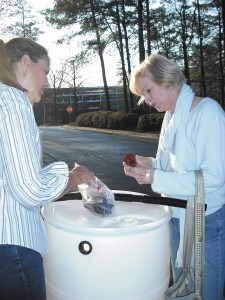By Jody Steinberg
Twenty-five more Dunwoody residents will be able to do their part to conserve water after each installs a 60-gallon barrel to collect rainwater for outdoor watering. They took the barrels home from a class hosted by the Upper Chattahoochee Riverkeeper.
During her one-hour presentation, Bonny Putney, outreach manager for the Riverkeeper’s Headwater’s office in Gainesville , stressed the urgent need in metro Atlanta to conserve water year round.
Meeting metro Atlanta’s demand on the Chattahoochee River, the metro area’s primary water source, Putney said, will require that we change our wasteful ways. About 3.5 million people in the metro Atlanta region depend on the Chattahoochee for water. By 2050, that number will reach 6.5 million, she said.
The high rate of development increases demand for land and energy, Putney said, and the area destroys watershed by covering land — nature’s water filtration system — with impervious pavement. “We lose 55 acres of capture area to pavement each day in Georgia,” Putney said.
One way homeowners can help, she ,said, is by using rain barrels to collect rainwater for watering their gardens.
“I call it the gateway drug to conservation,” said Putney. “Once people start using rainwater to water their gardens, they start looking for other ways to conserve and go green. I haven’t used city water for outside watering for years.”
During the March 22 class at Dunwoody City Hall, she demonstrated how to install the simple kit the Riverkeeper sells for $35 that allow homeowners to turn a barrel into a working rain-collection device. Each drum was distributed with a bag with all the necessary components and installation instructions.
Rain barrels
Q: How does a rain barrel work?
A: A large barrel or series of barrels is connected to a gutter
downspout to capture and store the roof runoff. A one-inch rainfall produces 600 gallons per 1,000 square feet of roof surface.
Q: Is rainwater bad for my plants?
A: Soil serves as a natural filter, so rainwater is fine for plants. In
fact, some gardeners say it is better than chemically treated city water.
Q: Are rainwater barrels safe?
A: Yes, but the water is not drinkable.
Q: What do I need to make a barrel?
A: A 50-gallon to 60-gallon drum or trash can, a strong and stable platform to keep the barrel at least a foot off the ground and an assembly kit. The Riverkeeper’s kit includes flexible pipe to connect the gutter to the barrel and tight seals for all connections, a threaded tap to connect a hose, a diversion spout to install inside the gutter to direct water towards the flexible pipe and a drill bit that is the same size as the connector seals.
The class, which cost $35, was sponsored by the Dunwoody Sustainability Commission and the Riverkeeper. The Coca-Cola Co. donated the recycled barrels for each participant to take home and convert into a rainwater collector.
A second class will be offered in April.
The Dunwoody group was the first to receive the new, simplified kits, which Putney was clearly pleased to distribute.
“I really worked hard to make this easy because I want you to go home and install it and use it,” she said.
Putney had drilled holes into a former Coca-Cola syrup drum to allow installation of an intake pipe and a tap, and explained how the flexible pipe connects to a valve inside a home’s gutter downspout. The system diverts water to the barrel until it fills, at which point the gutter continues to do its job.
Class participants loaded their huge drums into their cars, ready to go home, paint and install them. Mag Firebaugh looked forward to getting hers home. She had planted a full garden this season, she said, and wanted a way to water it more efficiently.

